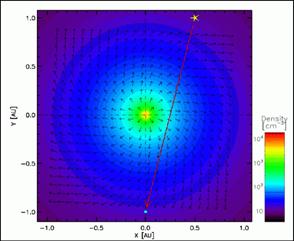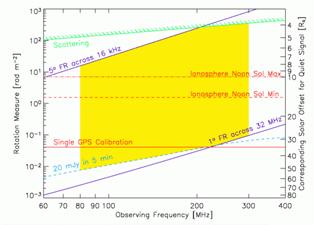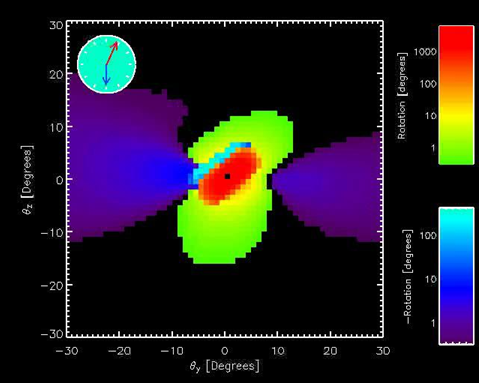Faraday Rotation (FR)
A primary objective of the Faraday Rotation (FR) measurement is to diagnose magnetized plasmas by determining variations in the Rotation Measure (RM) along lines of sight (LOS) from the MWA through the plasmas to distant sources. The RM is proportional to the integral along the LOS of the electron number density and the projection of the vector magnetic field along the LOS.
The MWA heliospheric FR measurements are aimed at (a) improving our understanding of the evolution of the solar magnetic field from the corona into interplanetary space, (b) characterizing the magnetic field strength and orientation within the flux ropes of Coronal Mass Ejections (CMEs) before they arrive at Earth, and characterize coronal turbulence by measuring the power spectrum of RM fluctuations and by monitoring source depolarization. Figure 1

Figure 1
Figure 1 illustrates a representation of the quiescent solar wind. The plasma density is encoded in the colors, while the magnetic field direction is shown by the arrows. The line-of-sight (in red) to a distant radio source passes through this medium, and experiences Faraday rotation. The amount of rotation is large at the MWA frequencies, and the measurements can yield constraints on the magnetoionic properties of the plasma. By observing many independent lines-of-sight, a 3-D representation can be built up.
To observe Faraday rotation, the MWA must find and use a sufficient surface density of polarized background sources. A recent survey at Westerbork of polarization at 340-370 MHz found 13 extra-galactic sources in an area of less than 35 square degrees, exhibiting typical polarized intensities of ~20 mJy and readily measurable RM. (Haverkorn et al., 2003). In the 200-300 MHz range of the MWA demonstrator, with a field of view in the 200-400 square degree range, we can expect over 100 sources in 5-minute integration with a single pointing. A survey of polarized sources will be conducted with the MWA as a first step in the process. Figure 2

Figure 2
Figure 2 illustrates the region (yellow) where Faraday rotation observations with the MWA are expected to yield useful constraints on the heliospheric plasma properties. The MWA observing frequency range from 80 to 300 MHz is shown on the abscissa, and the ordinate shows Rotation Measure (left) and the heliospheric distance at which the quiescent heliosphere would generate that amount of rotation (right). The different lines correspond to various constraints. The sloping lower lines are set by instrumental sensitivity, and the sloping upper lines by scattering and loss of phase coherence across the frequency channels. The horizontal red lines indicate levels of ionospheric Faraday rotation, which must be calibrated. For absolute calibration to remove the ionospheric effects, the MWA will utilize GPS observations which have been shown to be possible to a level of a few percent.

Figure 3
A simulation of the Faraday rotation from the flux rope that would have been observed by the MWA at 150 MHz during event of 28 October 2003 is shown in Figure 3 (J. Kasper), roughly six hours after the eruption of the CME. A substantial Faraday rotation signal is expected to be observable with the MWA whose measurement accuracy is estimated at 4 degrees for a 20 mJy source with an integration time of 5 minutes. Once the Faraday rotation is measured, an inversion or model fitting is then required to determine the magnetic field in the CME, utilizing knowledge of the electron density structure from other observations (e.g. STEREO) or from IPS as a first order estimate. Several groups have developed methods for such calculations (e.g. Liu et al, 2006). The observational and analysis techniques will be demonstrated with the MWA as a high priority as soon as the full array is deployed, and the MWA is then expected to contribute to space weather predictions in the long term once the operational capabilities are established and verified.
References
Liu, Y., W. B. Manchester, J. C. Kasper, J. D. Richardson and J. W. Belcher, "Determining the magnetic field orientation of coronal mass ejections from Faraday rotation", Astrophys. J., 665:1439-1447, 2007.

